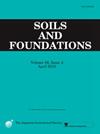Seismic passive earth pressures of narrow cohesive backfill against gravity walls using the stress characteristics method
IF 3.3
2区 工程技术
Q2 ENGINEERING, GEOLOGICAL
引用次数: 0
Abstract
A solution method for the determination of seismic passive earth pressures in narrow cohesive backfill behind gravity walls has been developed using the stress characteristics method. The stress characteristics method is combined with the pseudo-static method in the analysis to consider the effects of seismic forces. The failure mechanisms of backfill are complex when the backfill reaches its passive limit state. The stress characteristics method does not require pre-assumptions about the sliding surface and the plastic region of the backfill. This method automatically calculates the position of the sliding surface. The reliability and reasonableness of the proposed method are verified by comparing the sliding surface and seismic passive earth pressure calculated in this paper with the finite element calculation results, the existing experimental research results and the existing theoretical solution results. The effect of different parameters on seismic passive earth pressure is investigated by internal stress clouds of the backfill and the distribution of passive earth pressure on the retaining wall.
采用应力特性法计算窄粘性回填土对重力墙的地震被动土压力
利用应力特征法,开发了一种用于确定重力墙后窄粘性回填土中地震被动土压力的求解方法。在分析中,应力特征法与伪静力法相结合,以考虑地震力的影响。当回填土达到被动极限状态时,其破坏机制非常复杂。应力特性法无需预先假定回填土的滑动面和塑性区域。该方法可自动计算滑动面的位置。通过将本文计算的滑动面和地震被动土压力与有限元计算结果、现有实验研究结果和现有理论求解结果进行比较,验证了所提方法的可靠性和合理性。通过回填土的内应力云图和挡土墙上被动土压力的分布,研究了不同参数对地震被动土压力的影响。
本文章由计算机程序翻译,如有差异,请以英文原文为准。
求助全文
约1分钟内获得全文
求助全文
来源期刊

Soils and Foundations
工程技术-地球科学综合
CiteScore
6.40
自引率
8.10%
发文量
99
审稿时长
5 months
期刊介绍:
Soils and Foundations is one of the leading journals in the field of soil mechanics and geotechnical engineering. It is the official journal of the Japanese Geotechnical Society (JGS)., The journal publishes a variety of original research paper, technical reports, technical notes, as well as the state-of-the-art reports upon invitation by the Editor, in the fields of soil and rock mechanics, geotechnical engineering, and environmental geotechnics. Since the publication of Volume 1, No.1 issue in June 1960, Soils and Foundations will celebrate the 60th anniversary in the year of 2020.
Soils and Foundations welcomes theoretical as well as practical work associated with the aforementioned field(s). Case studies that describe the original and interdisciplinary work applicable to geotechnical engineering are particularly encouraged. Discussions to each of the published articles are also welcomed in order to provide an avenue in which opinions of peers may be fed back or exchanged. In providing latest expertise on a specific topic, one issue out of six per year on average was allocated to include selected papers from the International Symposia which were held in Japan as well as overseas.
 求助内容:
求助内容: 应助结果提醒方式:
应助结果提醒方式:


